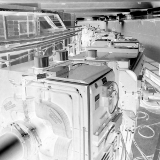Speaker
Andreas Eggenberger
(ETH Zurich)
Description
Towards a novel high-brightness muon beam line for next generation precision experiments
------------------------------------------------------------------------
Andreas Eggenberger$^1$ for the muCool collaboration
*$^1$Institute for Particle Physics, ETH, 8093 Zurich, Switzerland*
[www.edm.ethz.ch/research/muoncooling.html][3]
A recently proposed technique to significantly increase the brilliance of a muon (μ$^+$) beam [1, 2] opens the way for next generation low-energy particle physics experiments with both μ$^+$ and muonium (Mu = μ$^+$e$^−$). Precision experiments with μ$^+$, such as measurements of the muon g-2 or searches for the muon electric dipole moment, have the potential to find “new physics” at the multi-TeV scale. Interesting tests of bound-state QED as well as the determination of fundamental constants ($m_\mu$, $\alpha$, R$_\infty$) can be achieved by means of Mu spectroscopy. Furthermore, Mu is a purely leptonic system consisting to 99.5% of antimatter because of the much higher mass of the μ$^+$ compared to the e$^−$. Performing for example interferometric experiments may allow to test the gravitational interaction of antimatter.
The novel muon beam line is a tertiary beam line, which decreases the phase space of an already existing beam line by a factor of 10$^{10}$ with an efficiency of 10$^{−3}$, given mainly by the lifetime of the μ$^+$ and the time (8 μs) required to manipulate the μ$^+$: stop, compress and re-extract into vacuum. The basic idea is to stop MeV μ$^+$ from a standard surface muon beam in a helium gas target and compress the μ$^+$ swarm in several successive stages using crossed electric and magnetic fields. In the end the muons are extracted into vacuum again and accelerated, providing a pulsed eV-beam with 10 ns time information or a micro-beam with 10 keV energy of the order of 10 μm diameter.
The working principle is based on a position-dependent muon drift velocity vector $\vec{v}_D$. In a first stage the muons are stopped in a cryogenic helium gas target with a vertical gas density gradient (from 4 K to 12 K) inside a strong, longitudinal magnetic field. High, stationary electric fields compress the stopped muon swarm in transversal direction and guide it towards the second stage, which is at room temperature. In the second stage the muons are compressed in longitudinal direction and pushed towards the final stage, where a last compression occurs before the muons are extracted through a small hole into vacuum.
The second stage – the longitudinal compression – has been successfully demonstrated during our beam time in December 2014 at the new πE1 beam line at the Paul Scherrer Institute. Pre- liminary results from these experiments will be presented. Also, an overview over the ongoing preparations for the next beam time in December 2015 is given, which will focus on demonstrating transversal compression at cryogenic temperatures.
This work has been supported by the Swiss National Science Foundation under grant 200020_146902.
**References**
[1] D. Taqqu, Compression and extraction of stopped muons. Phys. Rev. Lett., 97 (2006).
[2] Y. Bao, et al. Muon cooling: Longitudinal compression. Phys. Rev. Lett., 112 (2014).
[3]: http://www.edm.ethz.ch/research/muoncooling.html
Author
Andreas Eggenberger
(ETH Zurich)
